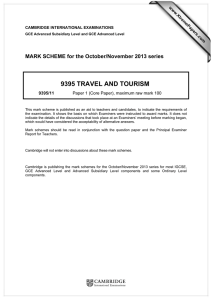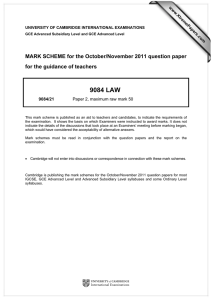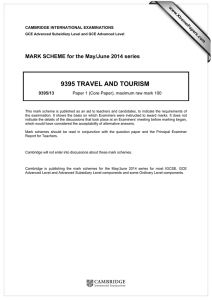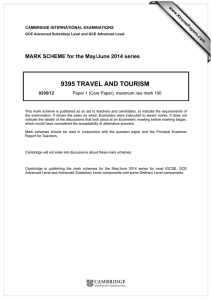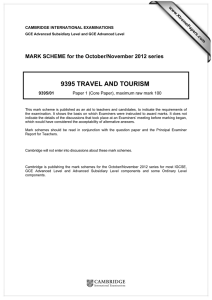9395 TRAVEL AND TOURISM MARK SCHEME for the May/June 2013 series
advertisement
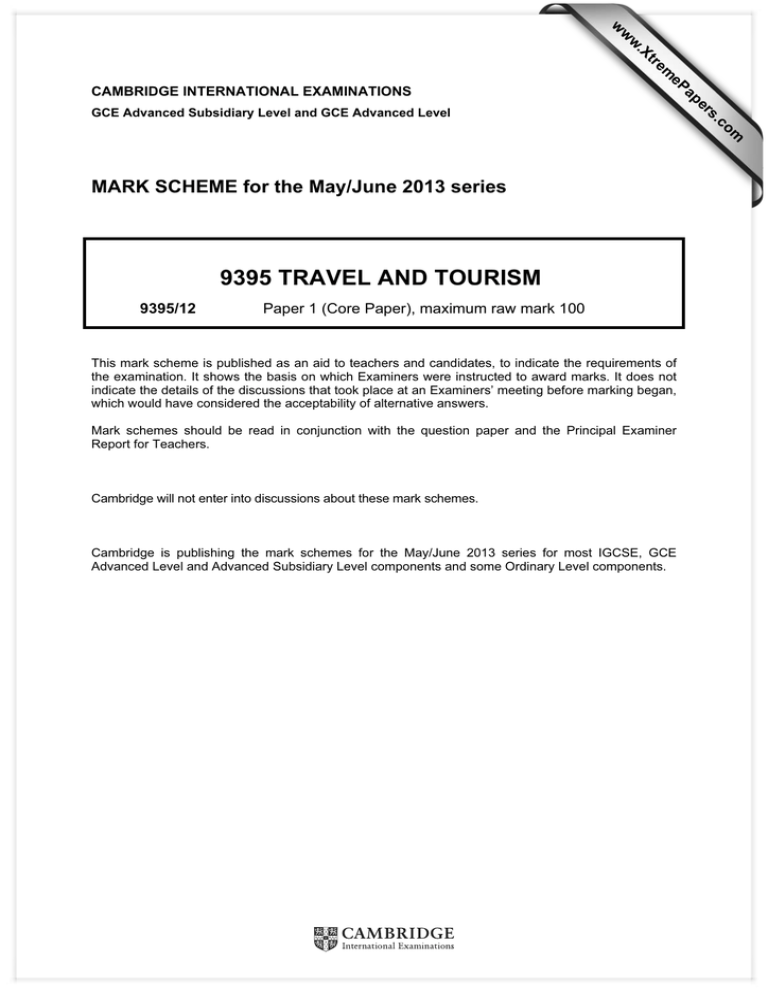
w w ap eP m e tr .X w CAMBRIDGE INTERNATIONAL EXAMINATIONS 9395 TRAVEL AND TOURISM 9395/12 Paper 1 (Core Paper), maximum raw mark 100 This mark scheme is published as an aid to teachers and candidates, to indicate the requirements of the examination. It shows the basis on which Examiners were instructed to award marks. It does not indicate the details of the discussions that took place at an Examiners’ meeting before marking began, which would have considered the acceptability of alternative answers. Mark schemes should be read in conjunction with the question paper and the Principal Examiner Report for Teachers. Cambridge will not enter into discussions about these mark schemes. Cambridge is publishing the mark schemes for the May/June 2013 series for most IGCSE, GCE Advanced Level and Advanced Subsidiary Level components and some Ordinary Level components. om .c MARK SCHEME for the May/June 2013 series s er GCE Advanced Subsidiary Level and GCE Advanced Level Page 2 1 (a) Mark Scheme GCE AS/A LEVEL – May/June 2013 Syllabus 9395 Paper 12 Identify four types of external customer served by the merged airline. [4] Award one mark for the correct identification of four types from: • • • • • • (b) uniformed military personnel First Business /Business First customers elite-level frequent flyers families (with children under the age of four) unescorted minors. Identify and explain three ways in which employees may benefit from the ‘Working Together’ culture. [6] Award one mark for the correct identification of each of three valid ways as indicated on Fig. 1 and award a second mark for an appropriate explanatory development for each such as: • • • • (c) on-time incentive (1) – employees will receive a benefit/reward for being punctual (1) perfect attendance (1) – employees will receive a benefit/reward for not having any absence from work (1) profit-sharing (1) – employees receive a bonus related to company profitability (1) and pass-travel programmes (1) – employees receive travel perks (1) Explain three ways in which the company is likely to receive employee feedback on the new operating procedures. Award one mark for the correct identification of each of three valid ways and award a second mark for an appropriate explanatory development for each such as: • • • • • Staff focus groups (1) – meetings held to consider procedures (1) Staff meetings (1) – briefing session have opportunities for Q&A (1) Staff suggestion boxes (1) – allows individuals to raise concerns (1) Complaints to supervisors (1) – reporting operational difficulties (1) Trade Union disputes (1) – official notification of issues (1) Credit all valid reasoning in HR context. © Cambridge International Examinations 2013 [6] Page 3 (d) Mark Scheme GCE AS/A LEVEL – May/June 2013 Syllabus 9395 Paper 12 For one job role within a travel and tourism organisation with which you are familiar, evaluate the customer service procedures employees are expected to follow. [9] Answer MUST be set in the context of a particular job within an identifiable T&T organisation or a 6 MAX limit will apply. The content is likely to vary, depending on the job role chosen, but the syllabus document is clear about the level of detail expected: Candidates should be able to explain identifiable customer service procedures that are appropriate for a particular operation. For example, staff duties in a hospitality environment would involve the ‘meeting and greeting’ functions of the face-to-face encounter such as: • • • • • • • • • • always acknowledge guests upon arrival and departure always walk guests at a comfortable pace assist the guest as much as possible always keep guests fully informed, e.g. about delays always smile and show enthusiasm never leave the table before everyone has sat down never leave the host stand unattended never argue with a guest always present a positive image of the organisation and its products never chew gum, eat, drink, swear or smoke while working. Use level of response criteria Level 1: [1–3 marks] Candidate identifies/describes some valid types of customer service procedures within an identifiable T&T organisation. Information may be a list of actions but explanations are incomplete and arguments partial (if present) and lack coherent organisation or reasoned conclusions. There is little or no attempt to evaluate. Level 2: [4–6 marks] Candidate identifies a number of valid types of customer service procedures to be followed by an employee within an identifiable T&T organisation. Candidates will show an understanding of the question and include explanations/analysis of a number of these, clearly indicating why tasks/actions are done in a particular way. Level 3: [7–9 marks] Candidates will show a clear understanding of the question and include detailed identification and explanation of particular types of procedure, clearly indicating their relative importance and significance to service delivery. The candidate effectively evaluates a range of procedures leading to a valid conclusion. 2 (a) Identify the four elements of the model of sustainable destination management. Award one mark for the correct identification of each of the following: • • • • Visitors Industry Community Environment © Cambridge International Examinations 2013 [4] Page 4 (b) Mark Scheme GCE AS/A LEVEL – May/June 2013 Syllabus 9395 Paper 12 Explain three ways in which it is possible for destinations to attract additional visitor spending. [6] Candidates should be aware that one of the main aims of those responsible for destination management is how they can attract visitor spending (both day and staying visits) into the area. This can be done in a number of ways. Award one mark for the correct identification of each of three valid ways and award a second mark for an appropriate explanatory development for each such as: • • • Advertising and promotion (1) – e.g. the running of campaigns in target markets. (1) Building of new facilities (1) – to appeal to different target markets. (1) Meeting the needs of different types of visitor types (market segments) (1) and advertising the facilities on offer. (1) NB – it is perfectly creditworthy to consider any 3 variations within one of the above categories. For example, in the City of Liverpool’s case, the creation of the ‘08’ brand and how this was used to highlight certain events / activities and the building of the ECHO Arena for leisure tourist concerts & business tourism conferences. Credit all valid reasoning. (c) Explain three negative economic impacts that can result from the rapid increase of wealthy foreign tourists visiting Less Economically Developed Countries (LEDCs). Award one mark for the correct identification of each of three valid negative economic impacts and award a second mark for an appropriate explanatory development for each such as: • Import leakage (1) – in LEDC’s, food and drinks must often be imported, since local products are not up to the hotel’s (i.e. tourists’) standards. (1) • Export leakage (1) Multi-national companies’ investors, who finance the resorts and hotels, take their profits back to their country of origin. (1) • 5* all-inclusives also tend to import more and employ fewer local people (1) and so a much smaller multiplier effect is felt within the local economy. (1) • Tourism development can cost the local government and local taxpayers a great deal of money (1) – resources spent on subsidised infrastructure or tax incentives may reduce investment in other critical areas. (1) • Inflation (1) – increasing demand for basic services and goods from tourists will often cause price rises. (1) Credit all valid reasoning. (d) Assess the methods frequently used by tourist boards to promote a destination in key overseas target markets. This should be quite familiar to candidates but it is expected that the methods quoted will be fully appropriate to an ‘overseas target market’. Thus, the better answers will give appropriate attention to ideas such as: • • • • Attending Fairs, e.g. WTM in London Media advertising campaigns Having an overseas office or representative Promotional materials in local language © Cambridge International Examinations 2013 [6] Page 5 Mark Scheme GCE AS/A LEVEL – May/June 2013 • Syllabus 9395 Paper 12 Hosting familiarisation trips for key agents, etc. Use level of response criteria Level 1: [1–3 marks] Candidate identifies/describes some valid types of method used. Information may be a list of actions but explanations are incomplete and arguments partial (if present) and lack coherent organisation or reasoned conclusions. There is little or no attempt to assess. [9] Level 2: [4–6 marks] Candidate identifies a number of valid methods used. Candidates will show an understanding of the question and include explanations/analysis of a number of these, clearly indicating why the methods are appropriate in context. Level 3: [7–9 marks] Candidates will show a clear understanding of the question and include detailed identification and explanation of particular types of procedure, clearly indicating their relative importance and significance to overseas market penetration. The candidate effectively assesses a range of procedures leading to a valid conclusion. 3 (a) Identify the following: [4] Award one mark for each correct identification as follows: • Visitors in 2009 = 7.5 million • Average daily spend = $142 • % increase in spending = 26.2% • % business = 22.3% (b) Describe what is meant by each of the following: • Convention • Trade Show • Corporate meeting Award one mark for simple definition and a second mark for some development, amplification or exemplification of each as follows: • Conventions are generally accepted as being multi-day events having at least 100 delegates (1) attending the event for the purpose of exchanging information. (1) Such an event is termed to be international if 40% of the delegates originate from outside of the host country. (1) Conventions are thus differentiated from meetings by both the duration of the event and the number of people attending. (1) • Trade Shows involve the bringing together of people for the purposes of viewing products and services (1) usually in a large hall such as a hotel ballroom. (1). • Corporate Meetings are defined as events designed to bring people together for the purpose of exchanging information (1) either from within one company/organisation or from a broader spectrum of people (1). © Cambridge International Examinations 2013 [6] Page 6 (c) Mark Scheme GCE AS/A LEVEL – May/June 2013 Syllabus 9395 Paper 12 Discuss the likely reasons for New Orleans wanting to attract 25 to 34 year old visitors. [6] Candidates should be aware that these will be: • • • DINKY – affluent & free to travel Have large repeat visit potential Frequent social media users – widening distribution opportunities Use level of response criteria Level 1 (1–2 marks) will identify up to two valid reasons, providing some detail but will be mainly descriptive. Level 2 (3–4 marks) can be awarded for an analysis of selected reasons, clearly explaining the value and suitability of the age group. Level 3 (5–6 marks) can be awarded for evaluative comment about the potential value of the age group. The better answers will have a reasoned conclusion. (d) New Orleans attracts a lot of domestic visitors. With reference to one destination with which you are familiar, assess the range of self catering accommodation that is available. A very straightforward question that invites candidates to show their knowledge and understanding of a destination with which they are familiar. However, a generic account not contextualised within an identifiable destination will be subject to a 6 Max limit. We should expect to see different grades of apartments, self-catering villas/cottages, camping and caravan sites, boats/barges etc. Use level of response criteria Level 1: [1–3 marks] Candidate identifies some valid types of accommodation within an identifiable destination. Information may be a list of types, explanations are incomplete and arguments partial (if present) and lack coherent organisation or reasoned conclusions. There is little or no attempt to assess. Level 2: [4–6 marks] Candidate identifies a number of valid types of accommodation to be found within an identifiable destination and candidates will show an understanding of the question and include explanations/analysis of a number of these, clearly indicating the nature of the appeal to different types of tourist. Level 3: [7–9 marks] Candidates will show a clear understanding of the question and include detailed identification and explanation of particular types of accommodation, clearly indicating their relative importance and relative appeal to various types of both domestic and international traveller. The candidate effectively assesses a range of provision leading to a valid conclusion. © Cambridge International Examinations 2013 [9] Page 7 4 (a) Mark Scheme GCE AS/A LEVEL – May/June 2013 Syllabus 9395 Paper 12 Identify four threats to Goa’s reputation as “a relaxed tropical beach paradise”. [4] Award one mark for the correct identification of each of the following threats: • • • • (b) murders muggings drunken behaviour drug gangs Explain three ways in which tourists might disturb places of worship. [6] Award one mark for the correct identification of each of three valid ways and award a second mark for an appropriate explanatory development for each such as: • Taking photos during services (1) – flash disrupts & distracts (1) • Noise (1) – disturbs devotions (1) • Improper dress (1) – offends locals (1) • Crowding/congestion (1) – limits locals’ access (1) • Touching/damaging fixtures (1) – negative impact (1) Credit all valid reasoning in context. (c) Explain three ways in which historic cultural attractions can generate funding for maintenance and renovation. Award one mark for the correct identification of each of three valid ways and award a second mark for an appropriate explanatory development for each such as: • Guided tours (1) – to view key exhibits (1) • Shop (1) – selling themed merchandise (1) • Meetings/conferences (1) – hire of rooms (1) • Exhibitions (1) – rent of space (1) • Weddings (1) – rooms & hospitality (1) • “Friends” (1) – membership fees (1) Credit all valid reasoning in context. © Cambridge International Examinations 2013 [6] Page 8 (d) Mark Scheme GCE AS/A LEVEL – May/June 2013 Syllabus 9395 Paper 12 Discuss the ways in which the development of tourism can spread economic benefits throughout a destination. This is essentially about the multiplier effect and candidates should pick up on the word spread. The key mechanism is shown in the following diagram Use level of response criteria Level 1: [1–3 marks] Candidate identifies some valid types of economic benefit likely to be spread within a destination. Information may be a list of types, explanations are incomplete and arguments partial (if present) and lack coherent organisation or reasoned conclusions. There is little or no attempt to discuss. Level 2: [4–6 marks] Candidate identifies a number of valid economic benefits and candidates will show an understanding of the question and include explanations/analysis of a number of these, clearly indicating the ways in which they spread. The concept of the multiplier is clearly understood and illustrated. Level 3: [7–9 marks] Candidates will show a clear understanding of the question and include detailed identification and explanation of particular types of economic benefit which are spread via the multiplier effect. The candidate clearly discusses their relative importance, leading to a valid conclusion. © Cambridge International Examinations 2013 [9]
